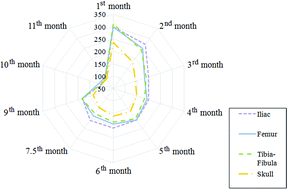The accumulation of lead in several bones of Wistar rats with time was determined and compared for the different types of bones. Two groups were studied: a control group (n = 20), not exposed to lead and a contaminated group (n = 30), exposed to lead from birth, first indirectly through mother's milk, and then directly through a diet containing lead acetate in drinking water (0.2%). Rats age ranged from 1 to 11 months, with approximately 1 month intervals and each of the collections had 3 contaminated rats and 2 control rats. Iliac, femur, tibia–fibula and skull have been analysed by Energy Dispersive X-ray Fluorescence Technique (EDXRF). Samples of formaldehyde used to preserve the bone tissues were also analysed by Electrothermal Atomic Absorption (ETAAS), showing that there was no significant loss of lead from the tissue to the preservative. The bones mean lead concentration of exposed rats range from 100 to 300 μg g−1 while control rats never exceeded 10 μg g−1. Mean bone lead concentrations were compared and the concentrations were higher in iliac, femur and tibia–fibula and after that skull. However, of all the concentrations in the different collections, only those in the skull were statistically significantly different (p < 0.05) from the other types of bones. Analysis of a radar chart also allowed us to say that these differences tend to diminish with age. The Spearman correlation test applied to mean lead concentrations showed strong and very strong positive correlations between all different types of bones. This test also showed that mean lead concentrations in bones are negatively correlated with the age of the animals. This correlation is strong in iliac and femur and very strong in tibia–fibula and skull. It was also shown that the decrease of lead accumulation with age is made by three plateaus of accumulation, which coincide, in all analysed bones, between 2nd–3rd and 9th–10th months.

You have access to this article
 Please wait while we load your content...
Something went wrong. Try again?
Please wait while we load your content...
Something went wrong. Try again?


 Please wait while we load your content...
Please wait while we load your content...